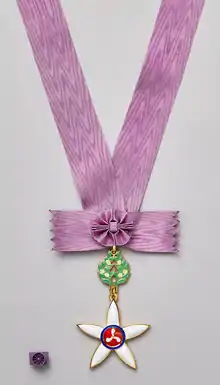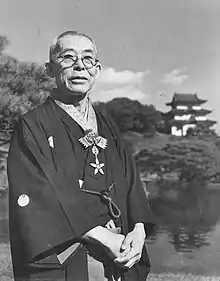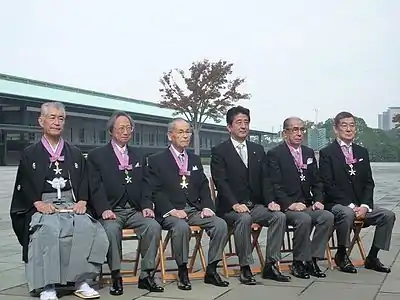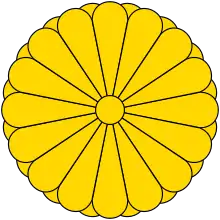Order of Culture
The Order of Culture (文化勲章, Bunka-kunshō) is a Japanese order, established on February 11, 1937. The order has one class only, and may be awarded to men and women for contributions to Japan's art, literature, science, technology, or anything related to culture in general; recipients of the order also receive an annuity for life. The order is conferred by the Emperor of Japan in person on Culture Day (November 3) each year.
| Order of Culture 文化勲章 | |
|---|---|
 Neck order of the award | |
| Awarded by the Emperor of Japan | |
| Type | Order |
| Awarded for | contributions to Japanese art, literature, or culture |
| Status | Currently constituted |
| Sovereign | His Imperial Majesty The Emperor |
| Grades | one class |
| Precedence | |
| Next (higher) | Order of the Sacred Treasure |
| Next (lower) | Order of the Precious Crown |
Ribbon of the order | |
The badge of the order, which is in gold with white enamel, is in the form of a Tachibana orange blossom; the central disc bears three crescent-shaped jades (magatama). The badge is suspended on a gold and enamel wreath of mandarin orange leaves and fruit, which is in turn suspended on a purple ribbon worn around the neck.
System of recognition

The Order of Culture and Persons of Cultural Merit function together in honoring contributions to the advancement and development of Japanese culture in a variety of fields such as academia, arts and others.[1]
Order of Culture
The Emperor himself presents the honor at the award ceremony, which takes place at the Imperial Palace on the Day of Culture (November 3). Candidates for the Order of Culture are selected from the Persons of Cultural Merit by the Minister of Education, Culture, Sports, Science and Technology, upon hearing views of all the members of the selection committee for the Persons of Cultural Merit. The Minister then recommends the candidates to the Prime Minister so that they can be decided by the Cabinet.[1]
Persons of Cultural Merit
The system for Persons of Cultural Merit was established in 1951 by the Law on Pensions for the Persons of Cultural Merit. The purpose is to honor persons of cultural merit by providing a special government-sponsored pension. Since 1955, the new honorees have been announced on the Day of Culture, the same day as the award ceremony for the Order of Culture.[1]
Selected recipients

A complete list can be found here.[2]
- Akira Ifukube (1914–2006). A composer of classical music and film scores.
- Ryukichi Inada (1874–1950). A physician, a prominent academic, and bacteriologist researcher.[3]
- Hideo Kobayashi (1902–1983). An author, who established literary criticism as an independent art form in Japan.
- Hantaro Nagaoka (1865–1950). A physicist and a pioneer of Japanese physics in the early Meiji period.
- Nakamura Kichiemon I (1896–1954). 1st kabuki actor to receive this honor.[4]
- Nakamura Utaemon VI (1917–2001). A famous kabuki actor, known for his oyama roles.[5]
- Kaii Higashiyama (1908–1999). A famous artist and writer, renowned for his Nihonga style paintings.[6][7]
- Kinjiro Okabe (1896–1984). An electrical engineering researcher and professor who developed the split-anode magnetron.
- Jirō Osaragi (1897–1973). A popular writer in Shōwa period.
- Junjiro Takakusu (1866–1945). An academic, an advocate for expanding higher education opportunities, and an internationally known Buddhist scholar.[8]
- Kenjiro Takayanagi (1899–1990). A pioneer in the development of television.[9]
- Morohashi Tetsuji (1883–1982). An important figure in the world of Japanese studies and Sinology.[10]
- Susumu Tonegawa (born 1939). A scientist who won the Nobel Prize for Physiology or Medicine in 1987.[11]
- Eiji Yoshikawa (1892–1962). A historical novelist.[12]
1992
- Masaru Ibuka (1908–1997). Co-founder, President and Chairman of Sony Corporation.[13]
1994
- Takashi Asahina (1908–2001). Orchestral conductor.[14]
- Tadao Umesao (1920–2010). Ethnologist.[15]
- Hideo Shima (1901–1998). Railway engineer.
1995
- Shigemitsu Dandō (1913–2012). Criminologist.[16]
- Shūsaku Endō (1923–1996). Writer.[16]
1996
- Hanae Mori (born 1926). Fashion designer.[17]
- Rizō Takeuchi (1907–1997). Historian of Japan.
1997
- Masatoshi Koshiba (1926–2020). Nobel Prize-winning physicist.[18]
- Hirofumi Uzawa (1928–2014). Economist.[18]
1998
- Ikuo Hirayama (1930–2009). Nihonga artist.[19]
- Tadamitsu Kishimoto (born 1939). Immunologist.[19]
1999
- Hiroyuki Agawa (1920–2015). Writer.[20]
- Fuku Akino (1908–2001). Nihonga artist.[21]
- Takeshi Umehara (born 1925). Scholar of Japanese cultural studies.[20]
2000
- Ryōji Noyori. Nobel Prize-winning chemist.[22]
- Hideki Shirakawa. Nobel Prize-winning chemist.[22]
- Isuzu Yamada. Actress.[22]
2001
- Chie Nakane. Social anthropologist.[23]
- Toshio Yodoi (1911–2005). Sculptor.[23]
2002
- Kyōhei Fujita (1921–2004). Glass artist.[24]
- Kaneto Shindō. Film director.[24]
- Kōichi Tanaka. Nobel Prize-winning scientist.[24]
2003
- Kazuhiko Nishijima (1926–2009). Physicist.[25]
- Sadako Ogata. Political scientist and diplomat.[25]
- Makoto Ōoka. Poet and literary critic.[25]
2004
- Yōji Totsuka (1942–2008). Physicist.[26]
- Nakamura Jakuemon, Kabuki actor.
- Toan Kobayashi, Seal carver.
- Shizuka Shirakawa, Scholar of Chinese-language literature.
- Horin Fukuoji, Nihonga painter.
2005
- Mitsuko Mori. Actress.[27]
- Makoto Saitō (1921–2008). Political scientist, specializing in American diplomatic and political history.[27]
- Ryuzan Aoki, Ceramic artist.
- Toshio Sawada, Civil engineer.
- Shigeaki Hinohara, Doctor.
2006
- Yoshiaki Arata. A pioneer of nuclear fusion research.[28]
- Jakuchō Setouchi. Writer/Buddhist nun.[29]
- Hidekazu Yoshida. Music critic.[29]
- Chusaku Oyama, Nihonga painter.
- Miyohei Shinohara, Economist.
2007
- Akira Mikazuki. Former justice minister and professor emeritus.[30]
- Shinya Nakamura. Sculptor.[31]
- Kōji Nakanishi. Organic chemist.[31]
- Tokindo Okada, Developmental biologist.
- Shigeyama Sensaku, Kyogen performer.
2008
- Hironoshin Furuhashi (1928–2009). Sportsman and sports bureaucrat.[32]
- Kiyoshi Itō. A mathematician whose work is now called Itō calculus.[33]
- Donald Keene. A Japanologist, scholar, teacher, writer, translator and interpreter of Japanese literature and culture.[33]
- Makoto Kobayashi. A physicist who was awarded the 2008 Nobel Prize in Physics.[33]
- Toshihide Masukawa. A theoretical physicist who was awarded the 2008 Nobel Prize in Physics.[33]
- Seiji Ozawa. A conductor, particularly noted for his interpretations of large-scale late Romantic works.[33]
- Osamu Shimomura. An organic chemist and marine biologist who was awarded the 2008 Nobel Prize in Chemistry.[33]
- Seiko Tanabe. Author.[32]
2009
- Sumio Iijima. Physicist.[34]
- Tōjūrō Sakata IV. Kabuki actor.[34]
- Katsura Beicho, Rakugo performer.
- Akira Hayami, Economist, Historian.
- Yorio Hinuma, Virologist.
2010
- Tadao Ando. Architect.[35]
- Akito Arima. Nuclear physicist.[35]
- Issei Miyake. Fashion designer.[35]
- Eiichi Negishi. Chemistry Nobel Prize laureate.[35]
- Yukio Ninagawa. Stage director.[35]
- Akira Suzuki. Chemistry Nobel Prize laureate.[35]
- Haruko Wakita. Medieval historian.[35]
2011
- Isamu Akasaki, Engineer.
- Ohi Chozaemon, potter.
- Saiichi Maruya, Author.
- Taichiro Mitani, Political and history scholar.
- Mitsuhiro Yanagida, Molecular biologist.
2012
- Shigeru Oda, Jurist, a judge on the International Court of Justice from 1976 to 2003.
- Yoji Yamada, Film Director.
- Shinya Yamanaka, Physiology Nobel Prize laureate, biologist.
- Shuji Takashina, art critic.
- Toshio Matsuo, nihonga painter.
- Yashuyuki Yamada, agronomist.
2013
- Ken Takakura, noted Japanese actor.
- Susumu Nakanishi, noted scholar of Japanese literature.
- Shunichi Iwasaki, noted scholar of electrical engineering.
- Seikaku Takagi, noted Japanese calligrapher.
- Tasuku Honjo, noted immunologist
2014
- Hiroshi Amano, Physics Nobel Prize laureate in 2014.
- Shuji Nakamura, Physics Nobel Prize laureate in 2014.
- Takemoto Sumitayu, narrator of Japanese bunraku, also known as a “ningyo joruri” (puppet theater).
- Taeko Kōno, writer and critic and is considered one of the most important contemporary writers of modern Japanese literature.
- Toyoki Kunitake, researcher in molecular architecture.
- Takashi Negishi, economist.
- Gyoji Nomiyama, Western-style painter.
Known to have declined the honor
- Kenzaburō Ōe, 1994 Nobel laureate and critic of the Japanese Imperial system.[36]
- Haruko Sugimura, actress.[37]
See also
- Order of Merit (UK)
- Pour le Mérite (Germany; recognised by the state, though not a state order)
- Ordre des Palmes Académiques (France)
- Order of Saint Catherine the Great Martyr (Russia)
- Order of Honour (Russia)
- Civil Order of Alfonso X, the Wise (Spain)
- Italian Order of Merit for Culture and Art
- Order of Cultural Merit (Korea)
- Order of the Direkgunabhorn (Thailand)
- Austrian Decoration for Science and Art
Notes
- Ministry of Education, Culture, Sports, Science and Technology (Japan): Culture 2000, Part 1, Chapter 3, Section 2.1
- 文化勲章受章者一覧 Archived 2016-09-13 at the Wayback Machine Nifty
- Fukuoka Medical School:
- 中村吉右衛門 (初代) Archived 2012-10-22 at the Wayback Machine
- Honor awarded 1979 -- Strom, Stephanie. Nakamura Utaemon VI, 84, International Star of Kabuki", New York Times 4 April 2001.
- "市川市|市川市名誉市民・市民栄誉賞". www.city.ichikawa.lg.jp (in Japanese). Retrieved 2017-07-13.
- "Kaii Higashiyama Exhibition - 宮城県公式ウェブサイト". www.pref.miyagi.jp (in Japanese). Retrieved 2017-07-13.
- Honor awarded 1944 -- Junijiro Takakusu Archived 2007-10-24 at the Wayback Machine
- Honor awarded 1981 -- "Kenjiro Takayanagi, Electrical Engineer, 91", New York Times, 25 July 1990.
- Honor awarded 1965 -- Sanjo City website Archived 2009-04-28 at the Wayback Machine: Morohashi Tetsuji Museum Archived 2015-09-23 at the Wayback Machine
- Frängsmyr, Tore. (1993). Nobel Lectures in Physiology or Medicine, 1981-1990, p. 380.
- Honor awarded in 1960 -- "Yoshikawa Eiji, in Encyclopædia Britannica. (2006).
- "Sony Global-Press Release-Masaru Ibuka 1908-1997", Sony Press Release Archive, Retrieved November 11, 2014.
- "Takashi Asahina, 93; Musical Director of Orchestra in Japan", Los Angeles Times, 31 December 2001.
- NEC (2 October 2002). "Brief Summary of Recipients' Careers". Press release. Retrieved 18 April 2010.
- Rockefeller University (October 26, 1995). "Japanese Government Honors Rockefeller University Professor for Cancer Research". Press release. Retrieved 18 April 2010.
- "Hanae Mori", Japan Times Online, 23 October 2007.
- "Order of Culture Awarded", Japan Foundation Newsletter, Vol. XXV, No. 6, March, 1998, page 6. (PDF) Archived 2012-02-22 at the Wayback Machine
- "Order of Culture", Japan Foundation Newsletter, Vol. XXVI, No. 4, February, 1999, page 7. (PDF) Archived 2012-02-22 at the Wayback Machine
- "Prime Minister Attends Order of Culture Award Ceremony", Prime Minister of Japan and His Cabinet (official website), November 3, 1999.
- "Thursday, November 11". japan.kantei.go.jp. Retrieved 2019-12-11.
- "Nobel chemist to get Order of Culture", Japan Times Online, 25 October 2000.
- "Five pioneers to receive Order of Culture awards", Japan Times Online, October 31, 2001.
- "Emperor honors six in culture, science", Japan Times Online, November 4, 2002.
- "Ogata, Ooka and others to receive Order of Culture", Japan Times Online, October 29, 2003.
- "Seal engraver, kabuki actor among honored cultural contributors", Forum Japon, October 29, 2004.
- "Five honored with Order of Culture", Japan Times Online, November 4, 2005.
- Arata receives award from Emperor of Japan on ISCMNS
- "Writing nun gets culture award", Japan Times Weekly Online, November 11, 2006.
- "Kyogen actor, four others chosen for culture awards". The Japan Times. Kyodo News. 28 October 2007. Retrieved 3 January 2013.
- "Kyogen actor, four others accept top culture awards", Japan Times Online, November 4, 2007.
- "Gov't decorates 3 Nobel winners, Seiji Ozawa, Donald Keene, 3 others", Japan Today, October 29, 2008.
- Honor awarded 2008 -- "Donald Keene, 7 others win Order of Culture," Yomiuri Shimbun. October 29, 2008.
- "Beicho, Tojuro among 5 recipients of year's top culture award", Seek Japan, October 27, 2009.
- "Nobelists Suzuki, Negishi get Order of Culture," Japan Times. October 27, 2010, retrieved 2011-04-20.
- Onishi, Norimitsu (May 17, 2008). "The Saturday Profile: Released From Rigors of a Trial, a Nobel Laureate's Ink Flows Freely". New York Times. Retrieved November 9, 2019.
- "杉村春子 自分で選んだ道ですもの". Nikkei Style. Retrieved July 3, 2017.
References
- Peterson, James W., Barry C. Weaver and Michael A. Quigley. (2001). Orders and Medals of Japan and Associated States. San Ramon, California: Orders and Medals Society of America. ISBN 978-1-890974-09-1
External links
- Japan, Cabinet Office: Decorations and Medals
- Decoration Bureau: Order of Culture
- Japan Mint: Production Process
